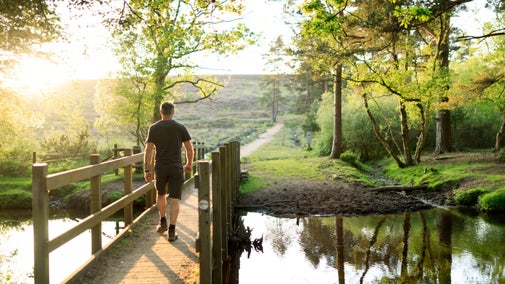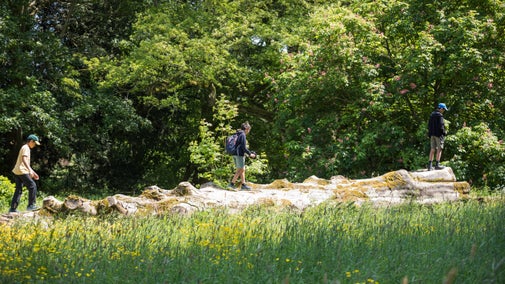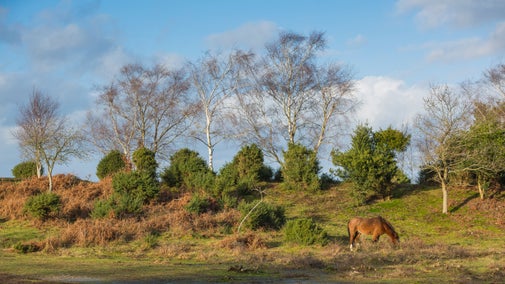
Discover more at New Forest Northern Commons
Find out how to get to the New Forest Northern Commons, where to park, the things to see and do and more.

The Northern Commons within the New Forest are a wide-open, boundary-less landscape, leading gently through heather plains and woodland to miniature valleys, swollen with bouncy bogs and gravel streams and home to an array of wildlife.
The New Forest is one of the best examples of lowland heathland in Britain. This is an internationally rare habitat. It includes a wide range of habitats, from bogs and mires to wet heath through to humid and dry heath. This undulating and varied landscape provides habitat for a vast array of rare and diverse wildlife.
Our New Forest Northern Commons can be defined by four distinct areas: Bramshaw Common, Rockford and Ibsley Commons, Hightown and Hale Purlieu.
Take in the boundless views from Stagbury Hill, the second highest point in the whole New Forest and a Bronze Age barrow site. Wander through the open wood pasture at Half Moon or the wetland bogs at Plaitford. Visit Stocks Cross, a former criminal punishment site containing stocks and gallows used until 1831.
Bramshaw is a centre of commoning and home to myriad wildlife species. It's well known for bird life, such as wood larks, nightjars and Dartford warblers, as well as dragonflies and butterflies.
The Bramshaw commons of Cadnam and Penshaw are also UK havens for one of Britain's most endangered plant species, the tiny yellow flowering fleabane.

Climb to the top of a hill or simply stroll through wild, open landscapes at Rockford Common, and take in extraordinary scenery and spectacular vistas at Ibsley.
Explore hidden and gentle valley systems, braided with mires and bogs, and exposed plateaux of heather dotted with character pine plantations, such as Robin Hood’s clump and Whitefield.
Paths wind though ancient woodland edges, eventually leading up through gorse and heather to reveal views of Cranborne Chase and the Purbeck hills of Dorset.
A small pocket of lowland heathland on the edge of the New Forest boasting stunning views to the south. Small but perfectly formed, Hightown is the New Forest in miniature, comprising all the lowland heathland habitats you would expect to find on some of the larger commons.
On the far north-western side of the New Forest, Hale Purlieu is made up of dry and wet heathland, comprising mires, bogs, scrub and woodland. It is one of the only National Trust sites in the New Forest where protected silver studded blue butterflies can be seen feeding among the heather, and nightjars are regularly heard 'churr'-ing during summer evenings.
The site has some of the finest examples of wetland valley mires in the Forest, hosting many rare species of bog flora. Being on the edge of the Forest, views from the Common’s high points looking south-east make the Forest look like an almost endless landscape of gentle valleys, open hillsides and woodland.
Cross streams and take in views across Hale Purlieu's valleys and mires with this 3 mile walk.
Our New Forest heathlands are home to five of Britain's six native reptiles. Adders are a common sight across the spring and summer, basking under gorse bushes in the morning sunshine.
From mid-late summer, the New Forest glows with shades of purple as swathes of heather begin to bloom, attracting silver-studded blue butterflies. Bright yellow gorse also appears in high summer. Bogs and pools sustain vast populations of breeding damselflies and dragonflies.
The New Forest is a stronghold for bats, with 16 out of the 17 UK species setting up home here. The Commons are actively managed for wildlife, including bats like the common pipistrelle and rare Bechstein’s and barbastelle varieties.
The reddish-brown/grey Dartford warbler has a distinctive shrill, scratchy call and a characteristic long grey tail. It usually nests in thick gorse bushes close to ground level, feeding on small invertebrates.
The mottled brown, nocturnal nightjar flies over from Africa in late April to breed in the UK. It creates its nests directly on the ground among the heathers. After sunset nightjars take to the wing to hunt moths and establish territories. Male nightjars produce a distinctive ‘churring’ call when perched on a tree branch, creating an air of mystery that in the past earned itself the name ‘goat sucker’. It was believed they drank milk from female goats at night.
The light-brown, speckled woodlark nests on the ground in short rough grass or heather. This bird is identifiable mainly by its distinctive call, a loud ‘lu-lu-lu’ of descending notes.

Find out how to get to the New Forest Northern Commons, where to park, the things to see and do and more.
New Forest Northern Commons is a one pawprint rated place. Find out more about where your dog can accompany you on a walk through the New Forest.

The New Forest has a long history that dates back almost a thousand years. Humans have been living within, changing and sustaining the forest since the Bronze Age.

Plan a visit to one of the special countryside places in our care and discover the benefits of being in the great outdoors. Pack your walking boots and get ready to explore woodlands, valleys and rivers.

Explore some of the finest landscapes in our care on coastal paths, accessible trails, woodland walks and everything in between. Find the best places to walk near you.

Enjoy the varied landscapes around Hampshire, from the huge expanses of New Forest common to the wildlife-rich downland and marshes of Stockbridge.
